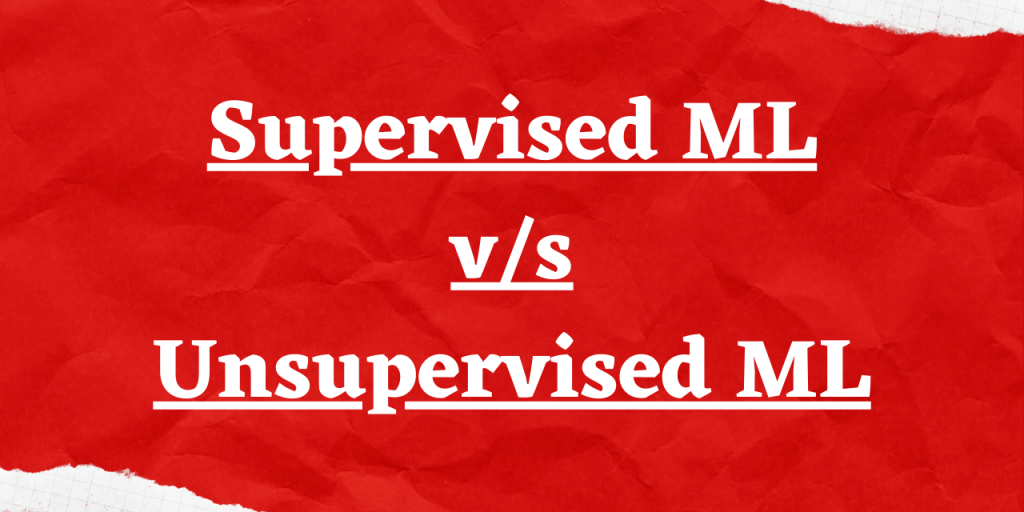Hello, readers! In this article, we will be focusing on the Differences between Supervised vs Unsupervised Learning, in detail.
Machine Learning has emerged as an important concept when it comes to modelling data values for understanding the trends. On a similar perspective, it offers us two types of mostly used algorithms – Supervised and Unsupervised ML algorithms.
Let us at first grasp a brief understanding of the same in the upcoming section.
So, let us get started!! 🙂
What is Supervised Learning?
Supervised Machine Learning is a division of Machine Learning wherein the model learns from the historic data values. That is, we feed the model with the historical data values (training dataset) and then the model/algorithm learns from the fed data to perform predictions on it.
When it learns from the historic data, it determines the patterns and uses them to perform predictions on the unknown data values. The data that is being fed to the model is completely labeled.
Common Supervised ML algorithms–
Let us now understand a few of the Supervised Machine learning algorithms to have an understanding of the concept of the same-
Linear Regression
With Linear regression, we try to have the best fit line to determine the dependent variable based on the impression from the data of independent variables.
That is, we feed the set of values to the algorithm (training dataset). Based on these values, the algorithm tries to find and predict the value for the dependent variable. All the variables here are linear in nature and even the end result values stand to be linear in nature.
Decision Trees
A Decision Tree is a Supervised Machine Learning algorithm with a flowchart structure. That is, it depends on a decision rule for the prediction of data values to happen. The internal nodes of the tree structure represent the attributes. The tree divides and partitions based on the values of these attributes. The splitting continues until all the nodes/attributes are exhausted.
What is Unsupervised Learning?
Unlike Supervised Machine Learning, an Unsupervised ML Algorithm does not learn from the historical data values. That is, it does not accept any learning data with patterns. Rather, it detects similar characteristics from the data and forms categories of the same for predictions.
It makes use of unlabelled data and then detects patterns within the same confines, and collects it into a grouped form that makes it easy for detection of the unknown data when fed.
Common Unsupervised Learning Algorithms –
With Unsupervised Learning algorithms, no training data gets provided. Let’s say, with K means clustering, the algorithm clusters the data for a particular value (n) and gathers the attributes that have similarities based on the independent variables.
Thus it proves the concept of detecting patterns. Basically, by word, we mean to say that the algorithm groups (clusters) out of n attributes considering some patterns and similarities based on other attributes around it.
Basic Differences Between Supervised vs Unsupervised Learning
Let’s get into the 3 differences between supervised and unsupervised learning.
1. Results on real-world datasets
Post predictions, when we think about the evaluation of the models, supervised machine learning models give us better results in terms of higher accuracy compared to unsupervised learning models.
The reason is that Supervised ML models learn from historic data and then perform the predictions which makes it more accurate. When we think of Unsupervised models it is a bit challenging for the algorithms to detect patterns and perform predictions since there is no historical dataset which may lead to lower accuracy in the beginning.
However, if the unsupervised model is given enough “practice” on real-world datasets, the accuracy can skyrocket as the model learns patterns that you may have not seen before. Again, this depends on the model and the type of data.
2. Nature of the input data
When it comes to Supervised learning algorithms, the input data fed to the model is labeled. That is how it enables the algorithm to detect patterns from the data.
On the other hand, unlabeled data is fed to unsupervised models wherein to detects similar characteristics and groups them.
3. Behavior of the training data model
When it comes to supervised machine learning, the model requires both the learning data and the output model to be fed. It is very well aware of the input and output values.
With unsupervised machine learning, only the input/training data is fed to the model. The model does not take the output of the prediction (for historical data) as input, which is completely unknown to it.
Conclusion
By this, we have come to the end of this topic. Feel free to comment below, in case you have any questions. For more such posts related to Python programming and machine learning, stay tuned with us.
Till then, Happy Learning!! 🙂
